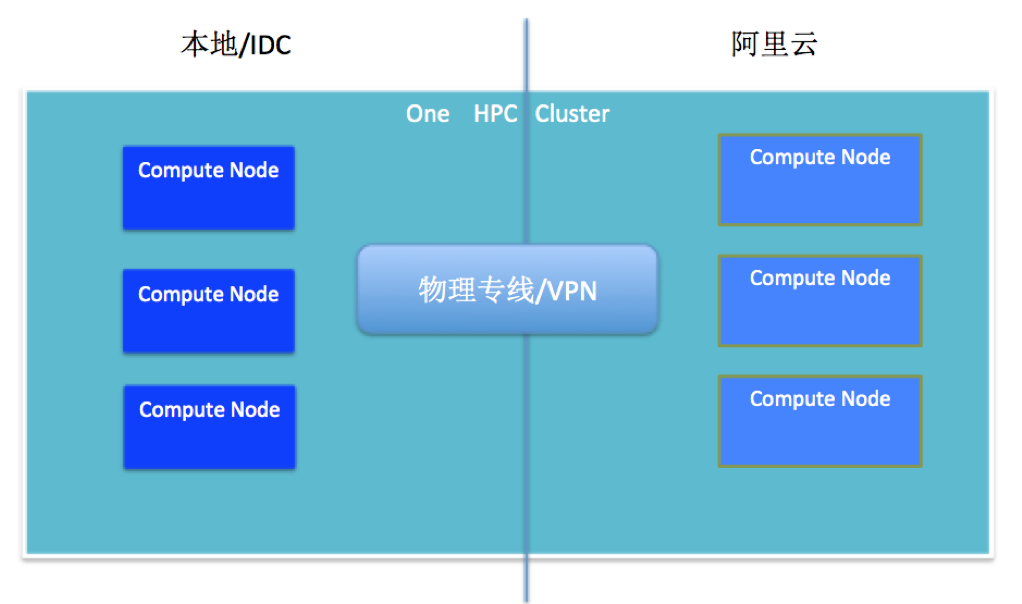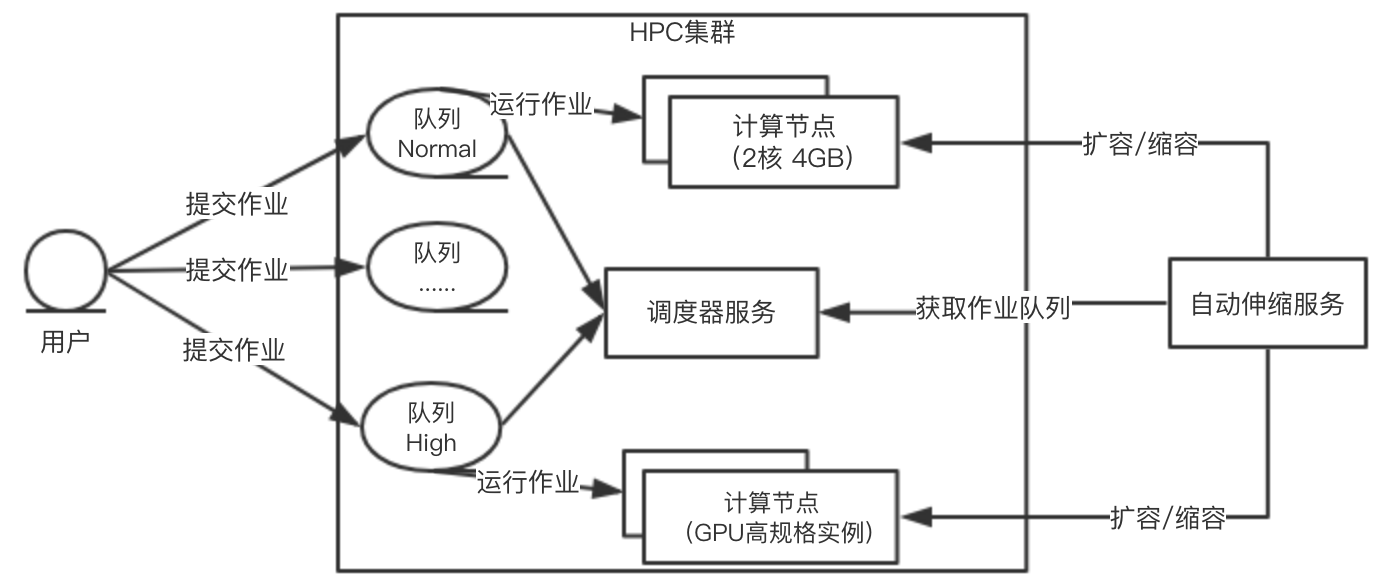阿里云E-HPC(弹性高性能计算)在最近的发布中支持多队列调度以及管理,另外发布针对多队列调度自动伸缩的策略支持。
本文主要介绍以下内容
- 多队列调度的应用背景和应用场景
- E-HPC支持多队列调度的功能实现
- 介绍各种HPC调度器类型对队列和节点组是如何配置管理的
- 介绍如何通过OpenApi的方式调用E-HPC多队列调度相关功能
前言
- 传统的HPC本地集群迁云过程中,部分会采用混合云的模式,例如如下模式,

云上计算资源规格可能是和本地的计算节点规格不一样,这就导致单个集群里需要支持多种规格的计算资源,HPC集群一般会用不同队列(job queue)或者节点组(node group)来管理不同规格的节点,然后分发作业到不同的队列以达到区分云上作业和本地作业;
- 有客户有需求在一个E-HPC集群里面运行不同类型作业,每种类型的作业对资源的需求是不同的,例如前处理作业需要普通8核32GiB内存的ECS虚拟机,后端计算性任务需要使用裸金属服务器。
E-HPC支持多队列
E-HPC通过发布以下功能支持多队列部署:
- 扩容的时候支持指定新的实例规格
- 创建集群和扩容的时候支持加入指定队列,如果队列不存在会自动创建队列
- 提交作业的时候支持提交到指定的队列

自动伸缩服务支持多队列弹性策略的配置,针对每个队列可以配置如下信息:
- 自动扩容的实例规格
- 扩容付费类型,是按量付费,或者抢占式实例
- 如果是抢占式实例,出价策略,是系统自动出价还是设定最高价格
其余的伸缩配置共享集群全局配置,也可以设定部分队列启用自动伸缩,部分队列不自动伸缩

HPC集群对多队列的支持
E-HPC支持创建部署多种HPC调度集群,不同HPC调度器类型对队列的支持情形是不同的,这里做一些简要的介绍
PBSPro
PBSPro有两种队列类型,
- execution: 可执行队列,作业必须在execution队列里才能被分发运行
- routing: 用来分发作业到其他队列,目标队列可以是routing或者execution队列
PBSPro默认会创建execution队列workq,该队列默认被创建和启用, 扩容节点时如果没有指定queue,队列workq里的作业可以分发到该节点计算。
以下是pbspro队列相关的命令
qmgr -c "create queue high queue_type = execution"
qmgr -c "set queue high started = true"
qmgr -c "set queue high enabled = true"
# 设置节点的队列信息为high,将只能运行队列high里的作业
qmgr -c "set node node001 queue = high"目前E-HPC对PBSPro集群队列的管理,都是针对execution队列
Slurm
Slurm里对应队列的概念是partitions,partitions可以认为是节点组,将节点分成多个set;partitions也可以被认为是作业队列,可以对该partition下运行的作业设置限制,例如作业运行时间限制,用户权限限制等等。
Slurm默认的partition是comp,所有计算节点都属于该partition
以下是Slurm关于partition的相关配置
# 创建新的partition,并且指定该partition节点, 但是该配置不是持久化的,重启slurmctld服务就会覆盖该配置
scontrol create PartitionName=heavy nodes=compute0
# 通过修改配置文件的方式
# 打开文件/opt/slurm/17.02.4/etc/slurm.conf, 可以看到文末的partition配置
PartitionName=comp Nodes=ALL Default=YES MaxTime=INFINITE State=UP
可以添加新的partition,例如
PartitionName=light Nodes=compute0,compute1 Default=YES MaxTime=INFINITE State=UP
# 重启slurmctld
system restart slurmctldLSF/CUBE
LSF或者CUBE的默认队列是normal, 所有的节点默认加入该队列,可以配置节点或者节点组加入某个队列,队列配置信息如下
# 打开队列配置文件lsb.queues (CUBE的配置路径是/opt/cubeman/etc, LSF类似)
# 增加如下队列配置
Begin Queue
QUEUE_NAME = high
PRIORITY = 30
NICE = 20
#QJOB_LIMIT = 60 # job limit of the queue
#UJOB_LIMIT = 5 # job limit per user
#PJOB_LIMIT = 2 # job limit per processor
#RUN_WINDOW = 5:19:00-1:8:30 20:00-8:30
#r1m = 0.7/2.0 # loadSched/loadStop
#r15m = 1.0/2.5
#pg = 4.0/8
#ut = 0.2
#io = 50/240
#CPULIMIT = 180/apple # 3 hours of host apple
#FILELIMIT = 20000
#MEMLIMIT = 5000 # jobs bigger than this (5M) will be niced
#DATALIMIT = 20000 # jobs data segment limit
#STACKLIMIT = 2048
#CORELIMIT = 20000
#PROCLIMIT = 5 # job processor limit
#USERS = all # users who can submit jobs to this queue
HOSTS = high # hostgroup high
#PRE_EXEC = /usr/local/lsf/misc/testq_pre >> /tmp/pre.out
#POST_EXEC = /usr/local/lsf/misc/testq_post |grep -v "Hey"
#REQUEUE_EXIT_VALUES = 55 34 78
DESCRIPTION = For normal low priority jobs, running only if hosts are \
lightly loaded.
End Queue
# 打开hostgroup配置文件lsb.hosts,最后增加节点组配置(CUBE的配置路径是/opt/cubeman/etc, LSF类似)
Begin HostGroup
GROUP_NAME GROUP_MEMBER # Key words
high (compute0 compute1) # Define a host group
End HostGroup
# 重启服务
service cubeman restartSGE(Sun Grid Engine)
SGE默认队列是all.q,默认节点组是@allhosts,所有节点都默认在该节点组
以下是SGE关于队列的相关配置
# 添加节点组
qconf -ahgrp @high
group_name @high
hostlist compute0 compute1
# 添加队列
qconf -aq high
指定节点组
hostlist @highAPI调用示例
由于部分客户和合作伙伴是通过OpenAPI和E-HPC对接,这里介绍一下API如何调用, 以python为示例代码,其他语言的示例代码可以通过OpenAPI Explorer来查看其他语言的示例代码
CreateCluster 创建集群
#!/usr/bin/env python
#coding=utf-8
from aliyunsdkcore.client import AcsClient
from aliyunsdkcore.request import CommonRequest
client = AcsClient('<accessKeyId>', '<accessSecret>','cn-hangzhou')
request = CommonRequest()
request.set_accept_format('json')
request.set_domain('ehpc.cn-hangzhou.aliyuncs.com')
request.set_method('GET')
request.set_version('2018-04-12')
request.set_action_name('CreateCluster')
# 设置队列,创建的计算节点会被指定为该队列,该队列会被自动创建
request.add_query_param('JobQueue', 'high')
# 设置CreateCluster其他参数
......
response = client.do_action_with_exception(request)AddNodes
#!/usr/bin/env python
#coding=utf-8
from aliyunsdkcore.client import AcsClient
from aliyunsdkcore.request import CommonRequest
client = AcsClient('<accessKeyId>', '<accessSecret>','cn-hangzhou')
request = CommonRequest()
request.set_accept_format('json')
request.set_domain('ehpc.cn-hangzhou.aliyuncs.com')
request.set_method('GET')
request.set_version('2018-04-12')
request.set_action_name('AddNodes')
# 设置队列,新扩容的计算节点会被指定为该队列,该队列如果不存在会被自动创建
request.add_query_param('JobQueue', 'high')
# 设置AddNodes其他参数
......
response = client.do_action_with_exception(request)ListQueues
新增API用于查询集群队列列表
#!/usr/bin/env python
#coding=utf-8
from aliyunsdkcore.client import AcsClient
from aliyunsdkcore.request import CommonRequest
client = AcsClient('<accessKeyId>', '<accessSecret>','cn-hangzhou')
request = CommonRequest()
request.set_accept_format('json')
request.set_domain('ehpc.cn-hangzhou.aliyuncs.com')
request.set_method('GET')
request.set_version('2018-04-12')
request.set_action_name('ListQueues')
request.add_query_param('RegionId', 'cn-hangzhou')
request.add_query_param('ClusterId', '<clusterId>')
response = client.do_action_with_exception(request)SubmitJob
#!/usr/bin/env python
#coding=utf-8
from aliyunsdkcore.client import AcsClient
from aliyunsdkcore.request import CommonRequest
client = AcsClient('<accessKeyId>', '<accessSecret>','cn-hangzhou')
request = CommonRequest()
request.set_accept_format('json')
request.set_domain('ehpc.cn-hangzhou.aliyuncs.com')
request.set_method('GET')
request.set_version('2018-04-12')
request.set_action_name('SubmitJob')
# 指定作业提交到该队列中
request.add_query_param('JobQueue', 'high')
# 设置SubmitJob其他参数
......
response = client.do_action_with_exception(request)SetAutoScaleConfig
#!/usr/bin/env python
#coding=utf-8
from aliyunsdkcore.client import AcsClient
from aliyunsdkcore.request import CommonRequest
client = AcsClient('<accessKeyId>', '<accessSecret>','cn-hangzhou')
request = CommonRequest()
request.set_accept_format('json')
request.set_domain('ehpc.cn-hangzhou.aliyuncs.com')
request.set_method('GET')
request.set_version('2018-04-12')
request.set_action_name('SetAutoScaleConfig')
# 对于队列high,设定扩容实例规格为GPU实例ecs.gn6v-c8g1.8xlargee,按量付费
request.add_query_param('Queues.1.QueueName', 'high')
request.add_query_param('Queues.1.InstanceType', 'ecs.gn6v-c8g1.8xlarge')
request.add_query_param('Queues.1.SpotStrategy', 'NoSpot')
request.add_query_param('Queues.1.SpotPriceLimit', '0')
# 对于队列low,设定扩容实例规格为ecs.g5.large,扩容抢占式实例,最高出价为0.1
request.add_query_param('Queues.2.QueueName', 'low')
request.add_query_param('Queues.2.InstanceType', 'ecs.g5.large')
request.add_query_param('Queues.2.SpotStrategy', 'SpotWithPriceLimit')
request.add_query_param('Queues.2.SpotPriceLimit', '0.1')
# 设置SetAutoScaleConfig其他参数
......
response = client.do_action_with_exception(request)LSF/CUBE集群的额外设置
LSF/CUBE由于需要license,在创建好集群之后,需要用户手动配置license认证,然后手动配置队列和节点组信息,配置方法在上述章节已经提及,然后后续扩容节点或者自动伸缩就可以做到自动化多队列管理





















 7841
7841











 被折叠的 条评论
为什么被折叠?
被折叠的 条评论
为什么被折叠?








